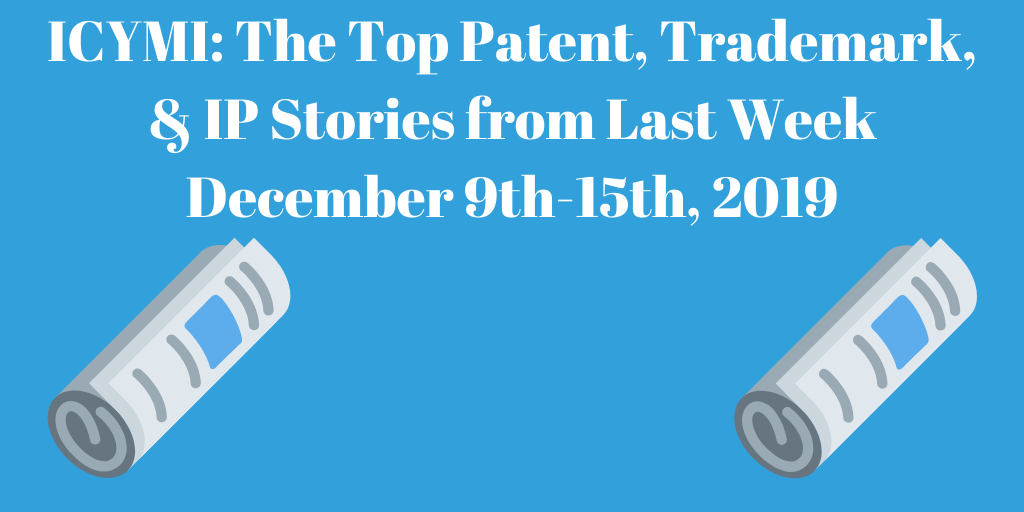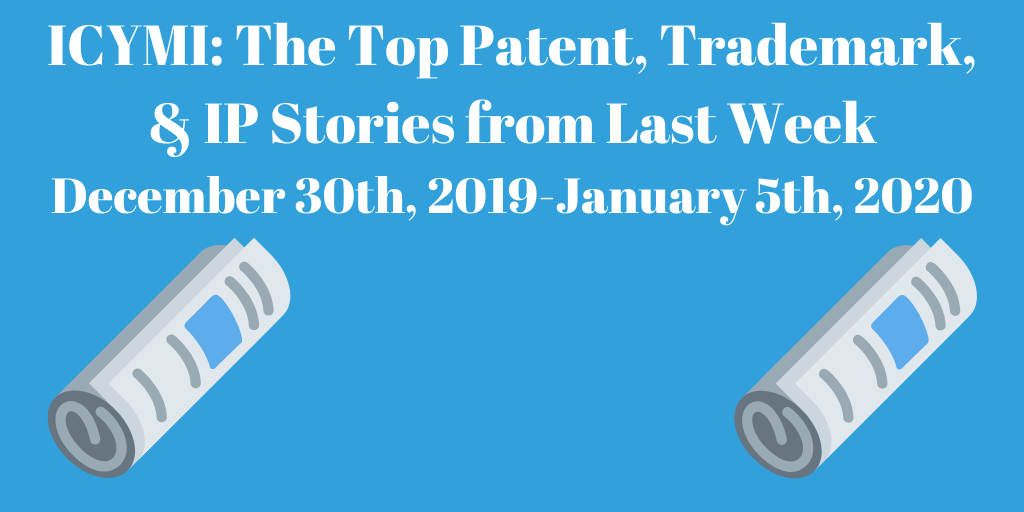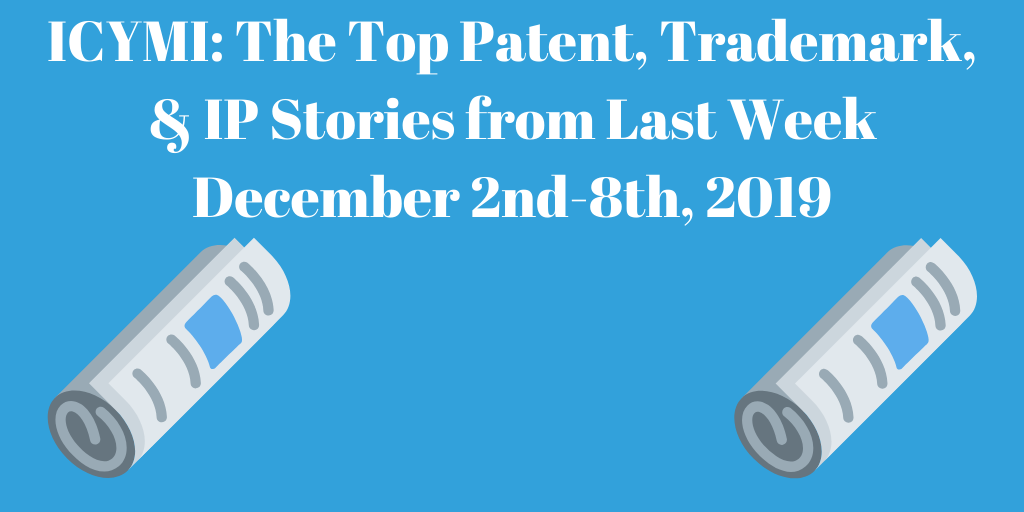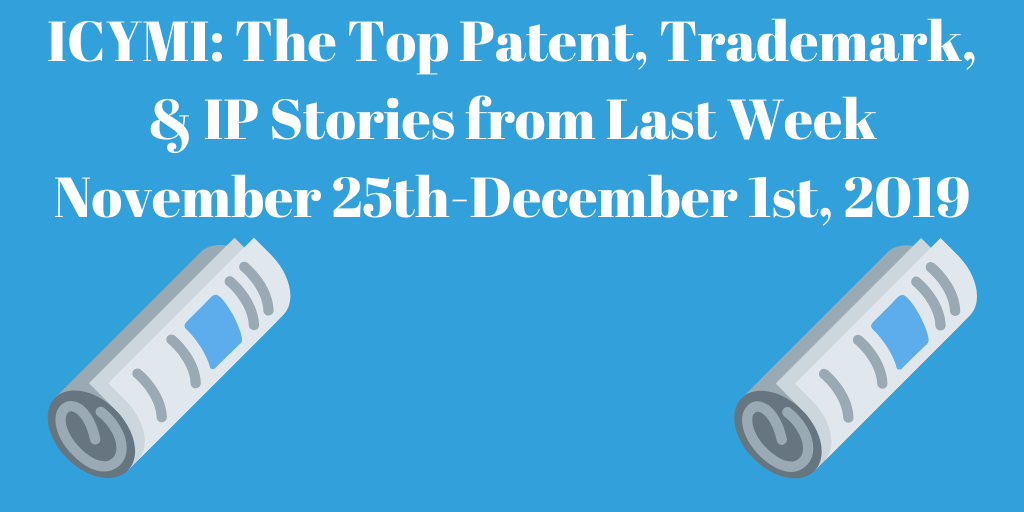Top Patent, Trademark, and IP Stories from Last Week (12/9-12/15/19)
Every week, we will be highlighting the top patent, copyright, trademark, intellectual property, etc. stories of the previous week in our “In Case You Missed It” segment. The list itself is in no particular order and includes a wide range of stories from the patent world that are informative, noteworthy, or just plain bizarre. The stories included encompass everything from Supreme Court cases to insights into growing industries. Please feel free to comment your thoughts on the stories or share an important one we missed!
“SCOTUS Rules That Fee-Shifting Is Patently Unfair When Patent (and Trademark?) Applicants Head to Federal District Court”
Back in the beginning of October, we covered how the Supreme Court was going to hear Peter v. NantKwest, Inc. In this case, the Court heard arguments over whether the line “all the expenses of the proceedings shall be paid by the applicant” in 35 U.S.C. § 145 “Civil action to obtain patent” includes USPTO attorneys’ fees. The USPTO had requested $80,000 in attorneys’ fees as reimbursement after a patent applicant challenged a PATB rejection in district court and lost. A 2018 Federal Circuit decision determined that attorneys’ fees are not included in § 145. Nonetheless, the USPTO brought their case to the Supreme Court.
On December 11th, the Supreme Court sided with the circuit court, ruling unanimously that “expenses” defined in § 145 do not include attorneys’ fees. In its decision, the Court cited “American Rule” as basis for the decision, the “bedrock principle” that “[e]ach litigant pays his own attorney’s fees, win or lose, unless a statute or contract provides otherwise.” The Court went on to say that “reading §145 to permit an unsuccessful government agency to recover attorney’s fees from a prevailing party” would be a “radical departure from long standing fee-shifting principles adhered to in a wide range of contexts.” Applicants who would like a review of rejected applications will not have to pay USPTO attorneys’ fees. To read more about this story, click here (via National Law Review, December 13th, 2019).
Intellectual Property (IP) Protection and Enforcement Measures Outlined in the USMCA
The new USMCA free trade agreement signed last week by the U.S., Canada, and Mexico will introduce new IP protection and enforcement measures without a change to current U.S. laws. As outlined on the U.S. Trade Representative website, measures include preserving patentability standards and patent office best practices to protect patents, establishing copyright safe harbors to deter online piracy, implementing safeguards for recognition and protection of new geographical indications (GIs), and enhancing broad trademark protections. Additionally, the agreement will implement a minimum copyright term of “life of the author plus 70 years.” For copyright terms not based on the life of a person, the default copyright term would be “a minimum of 75 years after first authorized publication.”
In contrast to NAFTA, the agreement will also implement a minimum protection length of 15 years for industrial design patents (vs. 10 years with NAFTA), mandate patent term extensions in the event of unreasonable patent office delays, and require prosecution for camcording (bootleg recording) as well as satellite and cable theft. Additionally, the measure gives border agents the ability to seize counterfeit goods, provides agricultural chemicals 10 years of data protection (vs. 5 years with NAFTA), strengthens trade secret protection and enforcement measures, and reaffirms the Doha Declaration on TRIPS and Public Health adopted by the WTO. These IP protection and enforcement measures are imperative to “driving innovation, creating economic growth, and supporting American jobs,” according to the USTR. To read more about this measure, visit the U.S. Trade Representative site here. NAFTA comparisons also provided by USTR and can be found here.
“Nike Now Holds Patent for Blockchain-Based Sneakers Called ‘CryptoKicks”
A new patent from Nike outlines a method whereby blockchain will be used to uniquely register and identify an individual pair of sneakers. The measure aims to combat the growth of counterfeit sneakers and give collectors confidence they are purchasing authentic shoes. When a pair of sneakers are purchases, digital versions of the shoe will be created and attached to a user’s unique ID number. From here, the sneakers will be assigned a “cryptographic token” where “the digital shoe and cryptographic token collectively represent a ‘CryptoKick.” Information about the shoe will be contained in the blockchain as well, including color patterns, material used, cut, dimensional patterns, manufacturing info, etc.
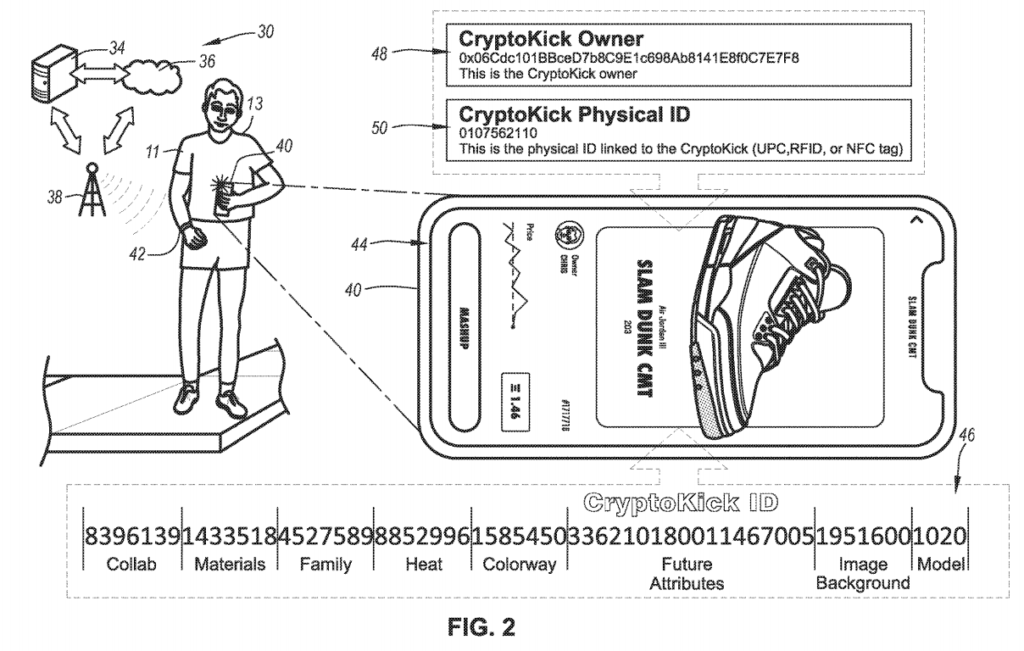
The patent also highlights the ability for consumers to “breed” shoes, selecting the traits they like between pairs of shoes and creating a digital form which Nike would replicate in the physical realm. To read more about this story, click here (via The Next Web, December 10th, 2019).
“EU Blocks Registration for ‘Contrary’ Marijuana Trademarks”
The European Union General Court ruled last week that logos featuring references to marijuana will not be eligible for trademark protection. The basis for the decision is that such references are considered “contrary to public policy and accepted principles of morality.” The decision comes after an applicant submitted a logo featuring the words “Cannabis Store Amsterdam” with the word “Cannabis” the most prominent and accompanied with green marijuana leaves. The court argues such a logo is a clear reference to narcotics, illegal in most of the E.U., and thus should not receive protection. Similar decisions have been made by the USPTO who have rejected marijuana-related trademark applications on the basis of marijuana being illegal under the Controlled Substances Act. To read more about this story, click here (via Bloomberg Law, December 12th, 2019).

